Jiashun Wang
Web2Grasp: Learning Functional Grasps from Web Images of Hand-Object Interactions
May 07, 2025Abstract:Functional grasp is essential for enabling dexterous multi-finger robot hands to manipulate objects effectively. However, most prior work either focuses on power grasping, which simply involves holding an object still, or relies on costly teleoperated robot demonstrations to teach robots how to grasp each object functionally. Instead, we propose extracting human grasp information from web images since they depict natural and functional object interactions, thereby bypassing the need for curated demonstrations. We reconstruct human hand-object interaction (HOI) 3D meshes from RGB images, retarget the human hand to multi-finger robot hands, and align the noisy object mesh with its accurate 3D shape. We show that these relatively low-quality HOI data from inexpensive web sources can effectively train a functional grasping model. To further expand the grasp dataset for seen and unseen objects, we use the initially-trained grasping policy with web data in the IsaacGym simulator to generate physically feasible grasps while preserving functionality. We train the grasping model on 10 object categories and evaluate it on 9 unseen objects, including challenging items such as syringes, pens, spray bottles, and tongs, which are underrepresented in existing datasets. The model trained on the web HOI dataset, achieving a 75.8% success rate on seen objects and 61.8% across all objects in simulation, with a 6.7% improvement in success rate and a 1.8x increase in functionality ratings over baselines. Simulator-augmented data further boosts performance from 61.8% to 83.4%. The sim-to-real transfer to the LEAP Hand achieves a 85% success rate. Project website is at: https://webgrasp.github.io/.
ASAP: Aligning Simulation and Real-World Physics for Learning Agile Humanoid Whole-Body Skills
Feb 03, 2025Abstract:Humanoid robots hold the potential for unparalleled versatility in performing human-like, whole-body skills. However, achieving agile and coordinated whole-body motions remains a significant challenge due to the dynamics mismatch between simulation and the real world. Existing approaches, such as system identification (SysID) and domain randomization (DR) methods, often rely on labor-intensive parameter tuning or result in overly conservative policies that sacrifice agility. In this paper, we present ASAP (Aligning Simulation and Real-World Physics), a two-stage framework designed to tackle the dynamics mismatch and enable agile humanoid whole-body skills. In the first stage, we pre-train motion tracking policies in simulation using retargeted human motion data. In the second stage, we deploy the policies in the real world and collect real-world data to train a delta (residual) action model that compensates for the dynamics mismatch. Then, ASAP fine-tunes pre-trained policies with the delta action model integrated into the simulator to align effectively with real-world dynamics. We evaluate ASAP across three transfer scenarios: IsaacGym to IsaacSim, IsaacGym to Genesis, and IsaacGym to the real-world Unitree G1 humanoid robot. Our approach significantly improves agility and whole-body coordination across various dynamic motions, reducing tracking error compared to SysID, DR, and delta dynamics learning baselines. ASAP enables highly agile motions that were previously difficult to achieve, demonstrating the potential of delta action learning in bridging simulation and real-world dynamics. These results suggest a promising sim-to-real direction for developing more expressive and agile humanoids.
Strategy and Skill Learning for Physics-based Table Tennis Animation
Jul 23, 2024Abstract:Recent advancements in physics-based character animation leverage deep learning to generate agile and natural motion, enabling characters to execute movements such as backflips, boxing, and tennis. However, reproducing the selection and use of diverse motor skills in dynamic environments to solve complex tasks, as humans do, still remains a challenge. We present a strategy and skill learning approach for physics-based table tennis animation. Our method addresses the issue of mode collapse, where the characters do not fully utilize the motor skills they need to perform to execute complex tasks. More specifically, we demonstrate a hierarchical control system for diversified skill learning and a strategy learning framework for effective decision-making. We showcase the efficacy of our method through comparative analysis with state-of-the-art methods, demonstrating its capabilities in executing various skills for table tennis. Our strategy learning framework is validated through both agent-agent interaction and human-agent interaction in Virtual Reality, handling both competitive and cooperative tasks.
SMPLOlympics: Sports Environments for Physically Simulated Humanoids
Jun 28, 2024

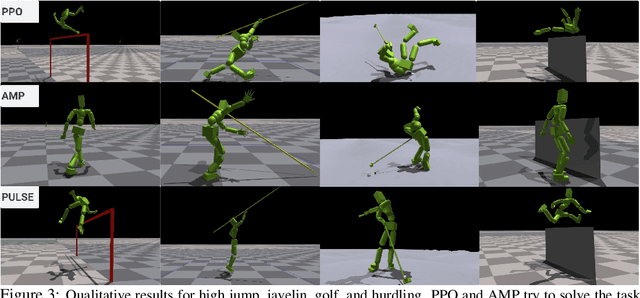

Abstract:We present SMPLOlympics, a collection of physically simulated environments that allow humanoids to compete in a variety of Olympic sports. Sports simulation offers a rich and standardized testing ground for evaluating and improving the capabilities of learning algorithms due to the diversity and physically demanding nature of athletic activities. As humans have been competing in these sports for many years, there is also a plethora of existing knowledge on the preferred strategy to achieve better performance. To leverage these existing human demonstrations from videos and motion capture, we design our humanoid to be compatible with the widely-used SMPL and SMPL-X human models from the vision and graphics community. We provide a suite of individual sports environments, including golf, javelin throw, high jump, long jump, and hurdling, as well as competitive sports, including both 1v1 and 2v2 games such as table tennis, tennis, fencing, boxing, soccer, and basketball. Our analysis shows that combining strong motion priors with simple rewards can result in human-like behavior in various sports. By providing a unified sports benchmark and baseline implementation of state and reward designs, we hope that SMPLOlympics can help the control and animation communities achieve human-like and performant behaviors.
H-InDex: Visual Reinforcement Learning with Hand-Informed Representations for Dexterous Manipulation
Oct 13, 2023Abstract:Human hands possess remarkable dexterity and have long served as a source of inspiration for robotic manipulation. In this work, we propose a human $\textbf{H}$and$\textbf{-In}$formed visual representation learning framework to solve difficult $\textbf{Dex}$terous manipulation tasks ($\textbf{H-InDex}$) with reinforcement learning. Our framework consists of three stages: (i) pre-training representations with 3D human hand pose estimation, (ii) offline adapting representations with self-supervised keypoint detection, and (iii) reinforcement learning with exponential moving average BatchNorm. The last two stages only modify $0.36\%$ parameters of the pre-trained representation in total, ensuring the knowledge from pre-training is maintained to the full extent. We empirically study 12 challenging dexterous manipulation tasks and find that H-InDex largely surpasses strong baseline methods and the recent visual foundation models for motor control. Code is available at https://yanjieze.com/H-InDex .
VoxDet: Voxel Learning for Novel Instance Detection
Jun 04, 2023Abstract:Detecting unseen instances based on multi-view templates is a challenging problem due to its open-world nature. Traditional methodologies, which primarily rely on 2D representations and matching techniques, are often inadequate in handling pose variations and occlusions. To solve this, we introduce VoxDet, a pioneer 3D geometry-aware framework that fully utilizes the strong 3D voxel representation and reliable voxel matching mechanism. VoxDet first ingeniously proposes template voxel aggregation (TVA) module, effectively transforming multi-view 2D images into 3D voxel features. By leveraging associated camera poses, these features are aggregated into a compact 3D template voxel. In novel instance detection, this voxel representation demonstrates heightened resilience to occlusion and pose variations. We also discover that a 3D reconstruction objective helps to pre-train the 2D-3D mapping in TVA. Second, to quickly align with the template voxel, VoxDet incorporates a Query Voxel Matching (QVM) module. The 2D queries are first converted into their voxel representation with the learned 2D-3D mapping. We find that since the 3D voxel representations encode the geometry, we can first estimate the relative rotation and then compare the aligned voxels, leading to improved accuracy and efficiency. Exhaustive experiments are conducted on the demanding LineMod-Occlusion, YCB-video, and the newly built RoboTools benchmarks, where VoxDet outperforms various 2D baselines remarkably with 20% higher recall and faster speed. To the best of our knowledge, VoxDet is the first to incorporate implicit 3D knowledge for 2D detection tasks.
Zero-shot Pose Transfer for Unrigged Stylized 3D Characters
May 31, 2023



Abstract:Transferring the pose of a reference avatar to stylized 3D characters of various shapes is a fundamental task in computer graphics. Existing methods either require the stylized characters to be rigged, or they use the stylized character in the desired pose as ground truth at training. We present a zero-shot approach that requires only the widely available deformed non-stylized avatars in training, and deforms stylized characters of significantly different shapes at inference. Classical methods achieve strong generalization by deforming the mesh at the triangle level, but this requires labelled correspondences. We leverage the power of local deformation, but without requiring explicit correspondence labels. We introduce a semi-supervised shape-understanding module to bypass the need for explicit correspondences at test time, and an implicit pose deformation module that deforms individual surface points to match the target pose. Furthermore, to encourage realistic and accurate deformation of stylized characters, we introduce an efficient volume-based test-time training procedure. Because it does not need rigging, nor the deformed stylized character at training time, our model generalizes to categories with scarce annotation, such as stylized quadrupeds. Extensive experiments demonstrate the effectiveness of the proposed method compared to the state-of-the-art approaches trained with comparable or more supervision. Our project page is available at https://jiashunwang.github.io/ZPT
ContactArt: Learning 3D Interaction Priors for Category-level Articulated Object and Hand Poses Estimation
May 02, 2023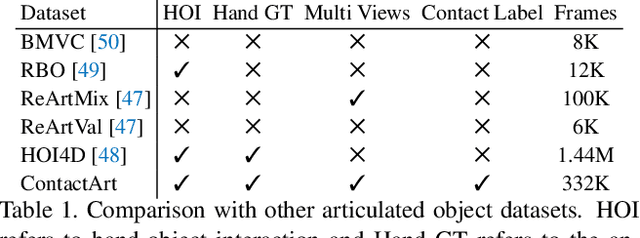

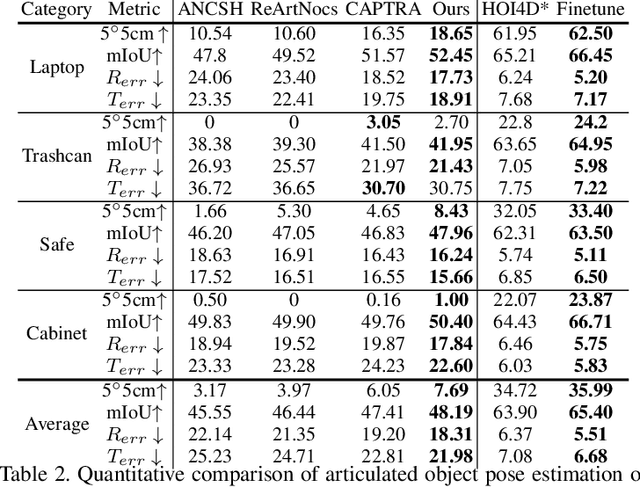
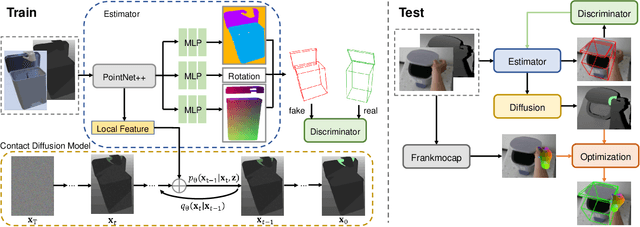
Abstract:We propose a new dataset and a novel approach to learning hand-object interaction priors for hand and articulated object pose estimation. We first collect a dataset using visual teleoperation, where the human operator can directly play within a physical simulator to manipulate the articulated objects. We record the data and obtain free and accurate annotations on object poses and contact information from the simulator. Our system only requires an iPhone to record human hand motion, which can be easily scaled up and largely lower the costs of data and annotation collection. With this data, we learn 3D interaction priors including a discriminator (in a GAN) capturing the distribution of how object parts are arranged, and a diffusion model which generates the contact regions on articulated objects, guiding the hand pose estimation. Such structural and contact priors can easily transfer to real-world data with barely any domain gap. By using our data and learned priors, our method significantly improves the performance on joint hand and articulated object poses estimation over the existing state-of-the-art methods. The project is available at https://zehaozhu.github.io/ContactArt/ .
USEEK: Unsupervised SE(3)-Equivariant 3D Keypoints for Generalizable Manipulation
Sep 28, 2022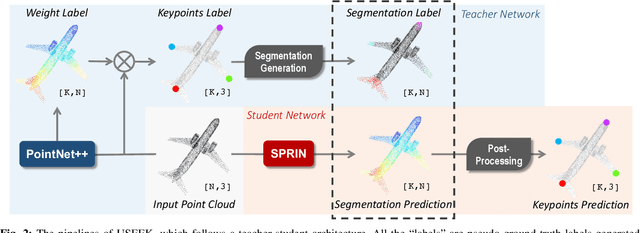
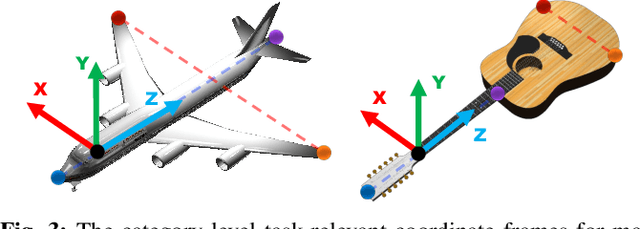


Abstract:Can a robot manipulate intra-category unseen objects in arbitrary poses with the help of a mere demonstration of grasping pose on a single object instance? In this paper, we try to address this intriguing challenge by using USEEK, an unsupervised SE(3)-equivariant keypoints method that enjoys alignment across instances in a category, to perform generalizable manipulation. USEEK follows a teacher-student structure to decouple the unsupervised keypoint discovery and SE(3)-equivariant keypoint detection. With USEEK in hand, the robot can infer the category-level task-relevant object frames in an efficient and explainable manner, enabling manipulation of any intra-category objects from and to any poses. Through extensive experiments, we demonstrate that the keypoints produced by USEEK possess rich semantics, thus successfully transferring the functional knowledge from the demonstration object to the novel ones. Compared with other object representations for manipulation, USEEK is more adaptive in the face of large intra-category shape variance, more robust with limited demonstrations, and more efficient at inference time.
Learning Continuous Grasping Function with a Dexterous Hand from Human Demonstrations
Jul 12, 2022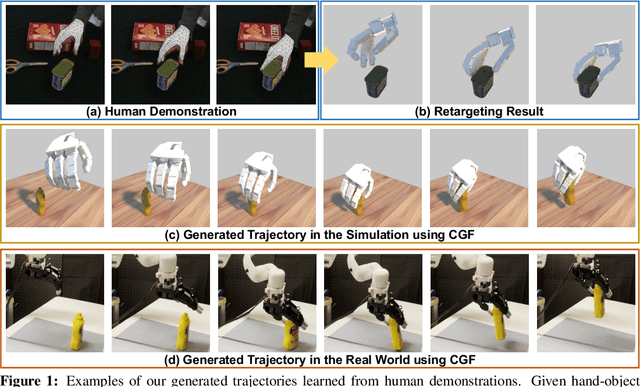

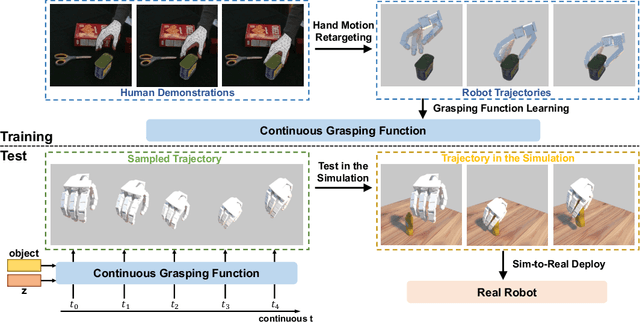

Abstract:We propose to learn to generate grasping motion for manipulation with a dexterous hand using implicit functions. With continuous time inputs, the model can generate a continuous and smooth grasping plan. We name the proposed model Continuous Grasping Function (CGF). CGF is learned via generative modeling with a Conditional Variational Autoencoder using 3D human demonstrations. We will first convert the large-scale human-object interaction trajectories to robot demonstrations via motion retargeting, and then use these demonstrations to train CGF. During inference, we perform sampling with CGF to generate different grasping plans in the simulator and select the successful ones to transfer to the real robot. By training on diverse human data, our CGF allows generalization to manipulate multiple objects. Compared to previous planning algorithms, CGF is more efficient and achieves significant improvement on success rate when transferred to grasping with the real Allegro Hand. Our project page is at https://jianglongye.com/cgf .
 Add to Chrome
Add to Chrome Add to Firefox
Add to Firefox Add to Edge
Add to Edge